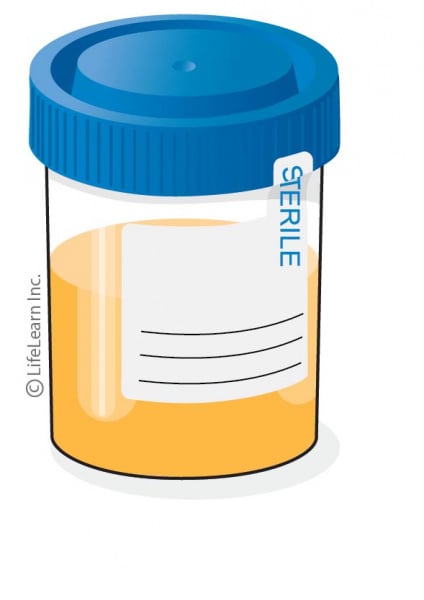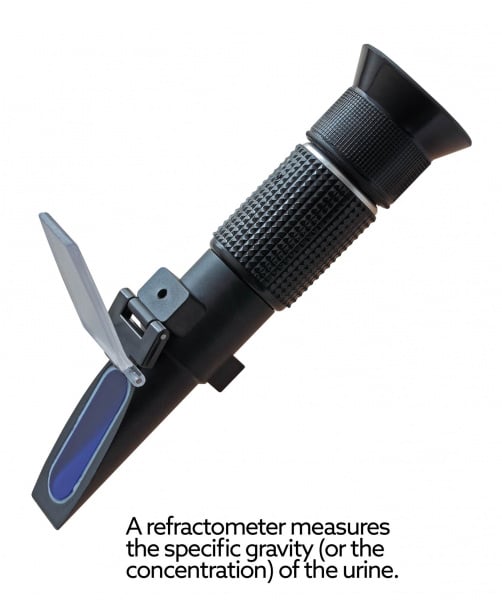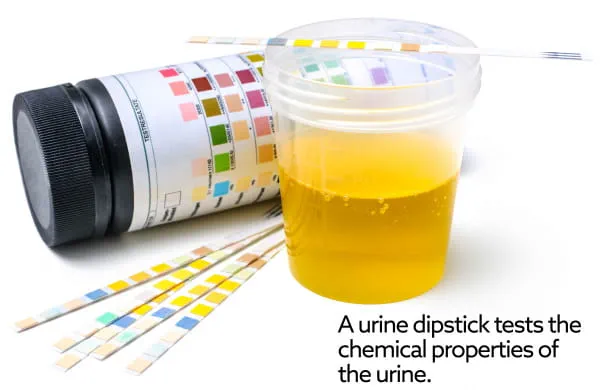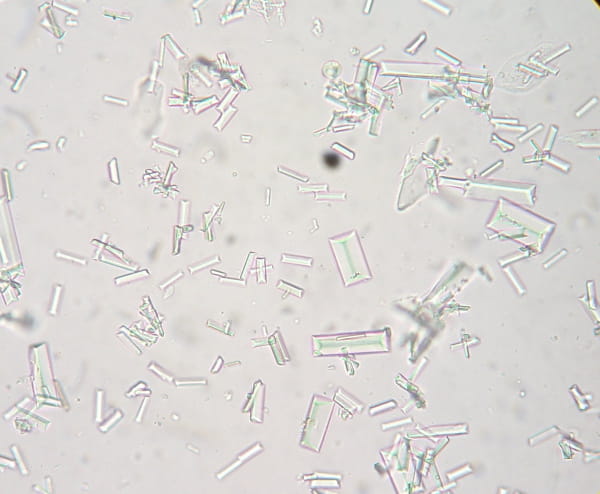Are The Kidney, Ureter, And Bladder Of Dogs And Cats Sterile In Healthy Animals
What is a urinalysis? 
Urinalysis is a routine test that reports the physical and chemical backdrop of urine. It is used mainly to assess the health of the kidneys and urinary system, but information technology can likewise reveal problems in other organ systems, and is of import for diagnosing metabolic disease such as diabetes mellitus. Information technology is a valuable test in both good for you and ill animals and should be included in any comprehensive evaluation of a pet'due south health.
How is urine collected?
There are three main means to collect urine in cats and dogs.
Cystocentesis. A sterile needle and syringe are used to collect urine from the float. The needle is passed through the abdominal wall into a full bladder and urine is withdrawn directly into the sterile syringe. The advantage of cystocentesis is that the urine is not contaminated by miscellaneous debris from the lower urinary passage. This blazon of sample is ideal for assessing the bladder and kidneys and for detecting bacterial infection. The disadvantages of cystocentesis are that the method is slightly more invasive than other methods, is useful only if the pet's bladder is full, and information technology is difficult to practice in patients that are uncooperative.
Catheterization. A very narrow sterile catheter is passed up the lower urinary passage (called the urethra) into the bladder. A sterile syringe is attached to the catheter and urine is withdrawn from the bladder into the syringe. The technique is less invasive than cystocentesis and is a skillful option when a voluntary sample is not bachelor, especially in male person dogs. Catheterization causes mild irritation to the urethra, and may carry bacteria from the urethra into the float.
Mid-stream gratis menstruation. Urine is voided voluntarily by pet in the usual way and a sample is collected into a sterile container as the pet urinates. Ideally, the sample is collected mid-stream, pregnant partway through urination. This blazon of sample is oftentimes chosen a "costless catamenia" or "free catch" sample. The advantages of this method are that information technology is completely non-invasive, and the pet possessor tin collect the urine sample at home. The disadvantages are that it may be difficult to collect a sample in mid-stream from some pets, and the urine is more than likely to be contaminated by miscellaneous debris from the urethra or the surroundings.
How is a urinalysis performed?
At that place are four parts to a urinalysis.
- Appraise advent: colour and turbidity (cloudiness).
- Mensurate concentration (also known as the density) of the urine.
- Mensurate pH (acidity) and analyze the chemical composition of the urine.
- Examine the cells and solid material present in the urine using a microscope.
Most of the assay is done on whole urine (as it comes from the animal), just the microscopic examination of cells and solid fabric requires the sample to be full-bodied or sedimented. To do this, urine is placed in a tube and then centrifuged (spun in a circle at very loftier speed) to forcefulness the cells and solid material to settle to the bottom. This accumulated cloth, or sediment, is collected and spread on a slide, and so examined under a microscope.
What do changes in color and turbidity (cloudiness) mean?
Normal urine is pale yellow to calorie-free amber and is generally clear to slightly cloudy. Urine that is nighttime xanthous commonly suggests the pet needs a drink of h2o or may be dehydrated. Urine that is very pale xanthous or clear suggests the pet is drinking a lot of water and urinating frequently; this may betoken underlying kidney affliction, or a disorder that interferes with the pet's ability to laissez passer concentrated urine. Urine that is any color other than yellow (for example orangish, cherry, dark-brown or blackness) may comprise substances not usually found in salubrious urine and may reflect injury or underlying affliction.
Increased turbidity or cloudiness indicates that in that location are cells or other solid materials in the urine. Examination of the sediment will determine what is present and whether it is meaning. Increased turbidity is typically associated with the presence of blood, inflammatory cells, crystals, mucus, or debris.
What is specific gravity and how does it help detect disease? 
It may aid to think of urine specific gravity as the density of the urine. A healthy kidney should produce dense (concentrated) urine, while watery (dilute) urine may signal underlying disease.
One of the kidney's jobs is to maintain the trunk's water level inside relatively narrow limits. If there is an backlog of water in the trunk, then the kidneys allow the excess water to pass out in the urine, and the urine becomes more watery or dilute. If at that place is a shortage of water in the torso (equally in dehydration), then the kidneys reduce the corporeality of h2o lost in urine, and the pet passes more concentrated urine.
Normal animals may pass dilute urine from time to fourth dimension during the twenty-four hour period, and a unmarried dilute urine sample is not necessarily a crusade for concern. If a pet continues to pass dilute urine, and so there could be underlying kidney or metabolic disease and further investigation is recommended.
What is urine pH and why is information technology measured?
Urine pH is a measure of how acidic or alkaline metal the urine is. The pH tin change with diet, but tin also signal the presence of infection or metabolic disease. Normal urine in cats and dogs ranges from mildly acidic to mildly alkaline. Extremes in urine pH beyond this range are more likely to be associated with disease.
How is the chemical analysis of the urine performed? 
The chemic analysis of urine is performed using a dipstick, which is a modest strip of plastic that holds a serial of individual exam pads. Each test pad measures a different chemical component and changes color to indicate the corporeality of that substance in the urine. The dipstick is dipped into the urine, and after a short waiting flow, the color of the test pads is compared to a nautical chart that translates the intensity of the colour to an actual measurement.
What substances are detected past the chemic analysis of urine?
Protein. The presence of protein in urine is called proteinuria. Mild proteinuria in a concentrated urine may non exist cause for concern, but proteinuria in dilute urine should be investigated since it may signal developing kidney disease. The significance of proteinuria is oftentimes determined by doing a 2d test called the protein:creatinine ratio (for more data, see handouts "Urine Protein", and "Urine Protein:Creatinine Ratio").
Glucose (sugar). Glucose should not be present in the urine of healthy cats and dogs. The presence of large amounts of glucose usually indicates the pet has diabetes mellitus. Small amounts of glucose in the urine may also be found in pets with kidney affliction.
Ketones. Ketones appear in urine whenever the torso breaks downwardly excessive amounts of stored fat to meet its free energy needs. This occurs near frequently in diabetes mellitus, simply can too be found in healthy animals during prolonged fasting or starvation.
Blood. Claret in the urine normally indicates there is bleeding somewhere in the urinary organisation. Sometimes this is due to how the sample was collected; for case, small amounts of claret are often found in samples collected by cystocentesis or catheterization. Claret in the urine is associated with diseases such as bacterial infection, float stones, trauma, or cancer, and then if claret in the urine does not appear to exist due to the sampling method, further investigation is recommended.
A positive reading for claret tin besides exist seen with a affliction called hemolytic anemia, in which red blood cells are destroyed and a protein called hemoglobin is released. Hemoglobin passes into the urine and causes the blood test pad to show positive, even though there is no actual haemorrhage in the urinary organization.
Occasionally the blood exam pad volition show positive for claret when there is musculus inflammation or injury. This is because damaged muscle fibers release a protein chosen myoglobin, which is very similar to hemoglobin. Myoglobin will too cause the blood test pad to bear witness positive, even though there is no actual bleeding in the urinary system. A specific test for myoglobin can be done if musculus injury is suspected.
Urobilinogen. The presence of urobilinogen in urine indicates that the bile duct is open up, and that bile can flow from the gall bladder into the intestine. A negative urobilinogen upshot has no interpretation and does non mean the bile duct is obstructed.
Bilirubin. Bilirubin is a substance that is produced in the liver and commonly excreted in the bile. Bilirubin is not found in the urine of healthy cats only may exist plant in small quantities in the urine of healthy dogs. Abnormal amounts of bilirubin in the urine are associated with liver affliction or red claret cell destruction (called hemolysis), and should ever exist investigated.
Why examine the urine sediment?
Urine sediment is the material that sediments out or settles into the bottom of the tube when a urine sample is spun in a centrifuge.
The most common things found in urine sediment are red blood cells, white claret cells, crystals, bacteria, and tissue cells from different parts of the urinary arrangement. Small amounts of fungus and miscellaneous debris are often found in free-catch samples. Rarely, parasite eggs are constitute in urine.
Red Blood Cells. Small numbers of red blood cells are often found in urine collected by cystocentesis or catheterization, just big numbers of cherry-red blood cells usually indicate bleeding. This may be acquired by weather condition such as bladder stones, infection, coagulation problems, trauma, cancer, etc.
White Blood Cells. Pocket-size numbers of white blood cells in a free-catch sample may not be pregnant, but in general, an increased number of white blood cells indicates inflammation somewhere in the urinary system. Inflammation is often secondary to bacterial infection.
Bacteria. The presence of both bacteria and inflammatory cells in the sediment indicates in that location is probable bacterial infection somewhere in the urinary system. Ideally, the urine should be sent to the laboratory for culture and sensitivity testing to find out what types of bacteria are nowadays and which antibiotic should exist used to treat the infection.
Crystals. At that place are many dissimilar types of crystals and they vary in size, shape, and colour. The significance of crystals also varies. 
Crystals in the urine do non always signal disease. Some crystals form when a pet is given certain types of medications. Crystals can also class in urine later on information technology has been nerveless, peculiarly if at that place is a long filibuster before the urinalysis is done. If this happens, your veterinary may wish to examine a fresh sample immediately afterwards it has been collected to make up one's mind if the crystals are significant. Image via Wikimedia Commons/Joel Mills (CC Past-SA 3.0.)
Tissue Cells. Increased numbers of tissue cells are often seen in samples nerveless by catheterization. While this is not a sign of illness, increased cellularity can be seen with a variety of disorders, including urinary tract inflammation, float stones, prostate issues (in the male dog), cancer etc. If the cells await aberrant, your veterinarian may recommend a cytological preparation of the sediment, which allows for a more than detailed examination of the tissue cells.
Source: https://vcahospitals.com/know-your-pet/urinalysis
Posted by: hayesaltylets.blogspot.com

0 Response to "Are The Kidney, Ureter, And Bladder Of Dogs And Cats Sterile In Healthy Animals"
Post a Comment